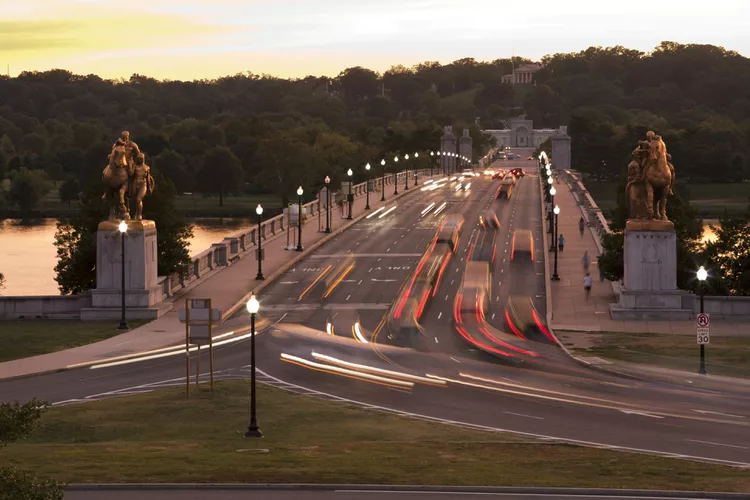Summary
Washington DC is home to seven major bridges across the Potomac River, six across the Anacostia River, and over a dozen scattered along Rock Creek Park. These bridges vary in aesthetic appeal; while some boast stunning views, others serve a primarily functional role. The metropolitan area features numerous bridges, facilitating daily transportation for hundreds of thousands of vehicles and forming a crucial part of the region’s infrastructure.
In recent years, many bridges have been categorized as structurally deficient, causing plans for repairs and upgrades to be initiated. Additionally, there are proposals to construct new bridges aimed at alleviating traffic congestion. Excitingly, planning is underway for a distinctive bridge-park combining recreation, environmental education, and artistic endeavors.
Arlington Memorial Bridge: Washington DC to Arlington VA
:max_bytes(150000):strip_icc():format(webp)/Arlington-Memorial-Bridge-Chris-Pecoraro-56a239ba3df78cf772736eb6.jpg)
Arlington Memorial Bridge, which is listed on the National Register of Historic Places, spans the Potomac River and is often regarded as Washington DC’s most picturesque bridge. This national memorial signifies the reunification of the North and South post-Civil War, establishing a direct connection between the Lincoln Memorial and the Arlington House, also known as the Robert E. Lee Memorial, situated at Arlington National Cemetery. The bridge, stretching 2,100 feet, was designed by the renowned architectural firm McKim, Mead, and White. Upon its inauguration in 1932, it was celebrated as the longest, heaviest, and fastest opening drawbridge in history, last opened on February 28, 1961.
14th Street Bridge: Washington DC
:max_bytes(150000):strip_icc():format(webp)/14th-St-Bridge-56a239ba3df78cf772736ebd.jpg)
The 14th Street Bridge (I-395 and US 1) serves as an essential entry point into Washington DC, bridging the Potomac River from Arlington, Virginia. This structure is actually a complex of five bridges; three accommodate automobile traffic, while one supports rail traffic (CSX, Amtrak, and VRE) and one for the Washington Metro. The site’s first bridge, established in 1809, was referred to as Long Bridge, undergoing multiple reconstructions over the years. The bridge faced damage during the tragic crash of Air Florida Flight 90 in 1982. Currently, it accommodates more traffic than originally predicted and is scheduled for improvements.
Francis Scott Key Bridge: Washington DC
:max_bytes(150000):strip_icc():format(webp)/Key-Bridge-glowimages-56a239bb5f9b58b7d0c80f7b.jpg)
The Key Bridge (US 29) features a six-lane arch design, spanning the Potomac River between Rosslyn, Virginia, and the Georgetown neighborhood of Washington DC. Constructed in 1923, it is the oldest bridge across the Potomac, named to honor Francis Scott Key, the composer of the Star Spangled Banner. Its northern end is near the location of Key’s former residence that was demolished in the 1940s. The bridge connects with M Street NW, Canal Road NW, and the Whitehurst Freeway, marking it as one of the most aesthetically pleasing bridges in Washington DC.
Theodore Roosevelt Bridge in Washington DC
:max_bytes(150000):strip_icc():format(webp)/Theodore-Roosevelt-Bridge-Medioimages-Photodisc-56a239bc3df78cf772736ec7.jpg)
The Theodore Roosevelt Bridge (Interstate 66/US Route 50) connects Rosslyn, Virginia, with Washington DC across the Potomac River and Theodore Roosevelt Island. Originally constructed in 1932, this bridge is dedicated to the 26th President of the United States. It provides the most straightforward route to access the Foggy Bottom neighborhood and the western parts of Downtown DC.
Future 11th Street Bridge Park: Washington DC
:max_bytes(150000):strip_icc():format(webp)/11th-st-rendering-56a239bc5f9b58b7d0c80f85.jpg)
The 11th Street Bridge serves as a vital connector between the Capitol Hill and Anacostia neighborhoods. This innovative project will transform the bridge into the city’s inaugural elevated park, offering a unique venue for recreation, environmental education, and arts.
Frederick Douglass Memorial Bridge: Washington DC
:max_bytes(150000):strip_icc():format(webp)/2756618470_25cf02a3cd_b1-5aa5d2c9119fa800373d2640.jpg)
The Frederick Douglass Memorial Bridge crosses South Capitol Street over the Anacostia River, linking I-295 with Suitland Parkway. Constructed in 1950, it is named in honor of theorist and abolitionist Frederick Douglass. The South Capitol Street Corridor Project has initiated plans for a new six-lane bridge that will connect to a park-like traffic circle, integrating South Capitol Street, R Street, Potomac Avenue, and the new structure.
Woodrow Wilson Bridge: Washington DC
:max_bytes(150000):strip_icc():format(webp)/Woodrow-Wilson-Bridge-56a239c15f9b58b7d0c80f99.jpg)
The Woodrow Wilson Bridge spans the Potomac River, linking Alexandria, Virginia, and Oxon Hill, Maryland. This drawbridge connects I-95 with I-495 (the Capital Beltway). Opened in 1961, the bridge is named after the 28th President of the United States. Major enhancements were executed to boost the bridge’s capacity in 2007 coinciding with the opening of National Harbor. The northern span features designated pedestrian and bike lanes, well-protected from the vehicular traffic.
Duke Ellington Bridge: Washington DC
:max_bytes(150000):strip_icc():format(webp)/Elllington-Martin-Ringlein-56a239be3df78cf772736ed9.jpg)
The Duke Ellington Bridge, named after the celebrated local jazz musician, traverses Calvert Street NW, spanning Rock Creek in Washington, DC. Built in 1935, it replaced an earlier bridge erected in 1891 primarily for streetcars. Remarkably, the Ellington Bridge features specialized barriers that prevent suicide attempts, making it one of the few of its kind in the United States.
Chain Bridge: Washington DC
:max_bytes(150000):strip_icc():format(webp)/Chain-Bridge-NCinDC-56a239bd3df78cf772736ed6.jpg)
Chain Bridge crosses the Potomac River at Little Falls, facilitating the connection between Arlington and Fairfax Counties in Northern Virginia. The DC side restricts left turns onto the Clara Barton Parkway, allowing only right turns. In Virginia, the bridge meets Chain Bridge Road (Route 123). A pedestrian sidewalk offers access to the Chesapeake and Ohio Canal towpath. This site has a storied history; the first bridge dates back to 1797 and was constructed of wood, succeeded by various bridges over the years, including some built from chains. The existing steel structure was completed in 1939.
John Philip Sousa Bridge: Washington DC
:max_bytes(150000):strip_icc():format(webp)/Sousa-Bridge-Tim-Evanson-56a239bf3df78cf772736edc.jpg)
The John Philip Sousa Bridge spans Pennsylvania Avenue SE across the Anacostia River, connecting with Barney Circle and the Anacostia Freeway (I-295). Established in 1939, it is named after the famous conductor and composer of the United States Marine Band, John Philip Sousa, who spent part of his youth near the bridge’s northwestern terminus. The first bridge erected on this site dates back to 1804.
Taft Bridge: Washington DC
:max_bytes(150000):strip_icc():format(webp)/Taft-Bridge-Mr-Tin-DC-56a239c05f9b58b7d0c80f95.jpg)
The Taft Bridge spans Connecticut Avenue NW over the Rock Creek Gorge in Washington DC. This Classical Revival style structure, completed in 1897, was dedicated to President William Howard Taft in 1931. Its distinct features include four sculptures of male lions seemingly at rest, along with 24 lampposts decorated with painted iron eagles.




